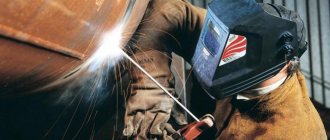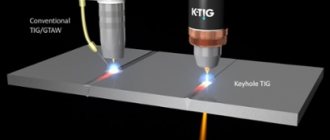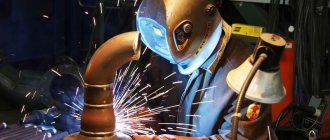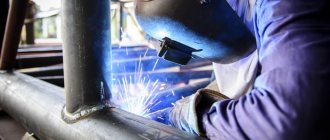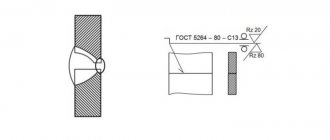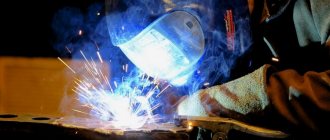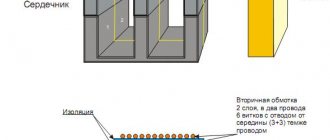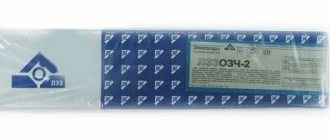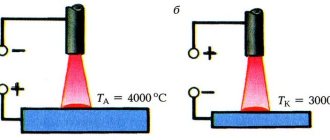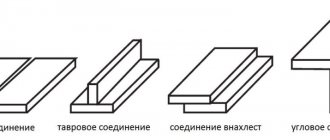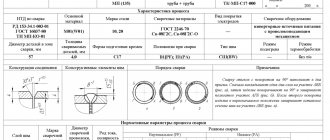Rail welding
When working with crane installations and installing railway tracks, the need arises for connecting and welding rails. In this case, a special technology is used, which ensures special connection strength and resistance to increased loads. It must be said that such work belongs to a separate category of welding work, the features of which we will discuss in this article.
Welding can be performed using the following technologies:
- Termite.
- Electric arc.
- Gas press welding.
Each of these technologies has its own specific disadvantages and advantages. Let's talk in more detail about these welding methods.
Basic methods
Welding of rail joints belongs to the category of particularly important activities, the organization and implementation of which is impossible without the use of equipment and modern welding mechanisms.
The main types of welding technologies used in the installation and repair of rails are:
- electric contact welding;
- electric arc method;
- thermite treatment (aluminothermic welding of rails);
- modern gas-press welding.
Each of these methods has certain advantages and disadvantages. To become more fully acquainted with them, we will consider each of the listed welding methods in more detail.
Electric arc welding of rail joints
Today, this technology has become most widespread, which is explained by the simplicity of the equipment, the ease of the work itself and the quality of the connection. When performing welding work, the rails are laid in the desired position, after which the space between the joints is filled layer by layer with welding material. Melting of the welding material is ensured by the high temperatures of the arc discharge. If it is necessary to weld the ends of the rails, alternating current from a transformer is used. It is also possible to use mobile welding machines operating on direct current.
When using electric arc technology, it is possible to weld rail joints using the bath method, in which rails cut perpendicular to their axis are mounted inside the bath. In the bath, they are qualitatively welded to each other. With this welding method, the rails are fixed with a gap of no more than 16 millimeters. The elevation of the profile can vary in the range of 3-5 millimeters.
When using the bath method, an electrode is placed between the ends, through which an electric current with a power of about 350 Amperes is supplied. The electrode quickly fills the gap between the rails being connected, evenly distributing the molten material over the entire section. This method eliminates the spreading of metal, while ensuring the highest quality closing of the gap between the connected metal elements. After welding is completed, it will be necessary to sand the connecting seam around the perimeter.
Aluminothermic rail welding
The thermite welding method is based on the ability of aluminum oxide and iron to react with each other at high temperatures. This thermite welding is also called aluminothermic technology. To perform this welding, a high-temperature resistant form is used, which in appearance is identical to the geometry of the rails. This form must withstand temperatures of more than 2000 degrees, at which contact between aluminum and iron occurs.
This welding technology was discovered at the end of the 19th century. However, due to its technological complexity, it became widespread only relatively recently. The main difficulties in performing such thermite welding are that the reaction of aluminum oxide and iron occurs only at temperatures of several thousand degrees. Accordingly, it was necessary to heat both the rails themselves to such extreme temperatures, and to use an appropriate form that could not melt and maintain its geometry.
To join metals, it is necessary to ignite the thermite mixture, which quickly burns out to produce a high temperature. Such a thermite portion contains not only aluminum and iron oxides, but also various alloying additives. Such additives are necessary to obtain the most durable connection with the required parameters of resistance to mechanical stress. During this temperature reaction, layer-by-layer separation of light slag and liquid steel occurs. In this case, the slag appears on top and is subsequently easily removed from the joint.
The thermite method of welding rails allows you to join bulk-hardened and surface-hardened materials. It must be said that with the help of such technology a strong and durable connection is ensured, therefore the thermite welding method has found application in the manufacture of jointless high-speed railways.
Gas press technology
This original rail joining technology involves the use of temperatures below the melting point, but due to high pressure, a high-quality rail connection is ensured. The advantages of this welding technology include the following:
- Excellent quality indicators of the connection made.
- Homogeneous structure of the railway pavement joint.
- High performance.
- Minimum consumption of deposited materials.
This type of gas press welding is widely used when joining heavy railway rails. When performing this, special equipment is used, which allows to ensure the highest possible pressure of the connected rails. The metal products are pressed tightly against each other, after which the ends are heated using a special clamp, and due to high pressure the rails are connected to each other. During such work, it is necessary to ensure that the elements being welded are washed with carbon trichloride. This allows for the connection of metal elements at the molecular level.
Operating temperature indicators for gas press technology are about 1200 degrees. For this type of work, multi-flame burners and powerful hydraulic presses are used. For high-quality heating of the joint, multi-flame burners are used, which carry out numerous vibrations in the area of the welded joint, which allows high-quality heating of the metal. The hydraulic press used to connect the rails provides a pressure of 13 tons or more. The shrinkage of rails when connecting them using this technology is about 20 millimeters.
Conclusion
Currently existing technologies make it possible to obtain a durable, reliable connection that is resistant to mechanical loads. The choice of one technology or another is made depending on the available equipment and the specific types of rails being connected. It must be said that a high-quality choice of such equipment used and following all the work technology will allow you to guarantee high-quality welding of rails.
Electrodes for welding railway rails
People who carry out large-scale construction or are simply accustomed to doing everything powerfully, then they probably face the problem of welding rails. Welding rails is a problem because they have a large diameter and, as a result, create obstacles for comfortable welding. Therefore, to weld rails, you need to use high-quality electrodes that allow you to be completely confident in the quality of the welded product.
Some of the electrodes that can be used for welding rails are UONI 13/45 or UONI 13/55. Yes, indeed, UONI welding electrodes are an excellent choice for welding such thick-bodied structures as rails.
UONI electrodes are used for welding critical metal structures when high requirements for impact strength are imposed on the metal seam. Many professional welders recommend UONI electrodes for welding structures operating under loads, pressure and other environmental factors.
Welding with UONI electrodes allows us to obtain high-quality metal that is highly resistant to cracking and hydrogen content. Welding with UONI electrodes can be performed in all spatial positions. For welding, you need to use direct current of reverse polarity.
The material for the manufacture of UONI welding electrodes is welding wire Sv-08A, which fully complies with state standards adopted in our country. Small cracks are allowed on the surface of the coating of welding electrodes, which may be on the coating of the welding electrode. However, if the coating of the welding electrode is severely damaged, then you need to check in which place you store them, because due to moisture, you can damage the welding electrode.
The coating of UONI welding electrodes has some features that require mandatory calcination before use. Calcination of SSNI electrodes is carried out at temperatures from 350 to 400 degrees Celsius.
Calcining the electrodes before welding makes it easier to work with them and allows you to make the weld seam made by them more durable. Also, calcining or drying the electrodes at the specified temperature makes them less susceptible to moisture.
As you can see, the use of UONI welding electrodes allows for high quality welding. Thanks to their high quality and welding features, you can start welding rails in a short time.
Welding rails is a difficult job, so in order for you to do it as quickly and efficiently as possible, you need to use UONI electrodes. Also, in order for you to be able to calcinate the UONI electrodes and store them in a suitable place, it is best for you to purchase a special oven for calcining electrodes.
elektrod-3g.ru
How to weld rails
The installation of railway lines is carried out using two methods: prefabricated and welded. The second is preferable because prefabricated joints reduce the speed of rolling stock. Welding of rails is carried out using several methods. When choosing a method for installing seamless lines, the weldability of the material and the cost of the work are taken into account. The most common are resistance and aluminothermic welding, there are other types. Each one is worth mentioning separately. The joints are welded using special equipment.
Types of rails
To select a welding method, the chemical composition of the alloy is taken into account. For each type of profile, GOST defines steel grades.
| Name | Purpose | Steel grades used for manufacturing |
| Railway standard | Produced for main roads | RP50, RP65, RP75. |
| Railway industrial | Used on short areas. | RP50, RP65, RP75. |
| Narrow gauge railways | Mounted in mines, on access narrow-gauge railways. | P8, P11, P18, P24. |
| Mine for mine conductors | Used for continuous wide-gauge sections, switches | P33, P38, P43 |
| Frame | Necessary for installation of line intersections. | PP65. |
| Crane | Designed for the movement of bridge and construction cranes. | KR70, KR80, KR100, KR120 and KR140. |
| Witty | Necessary for turnouts and circular support devices. | OR43, OR50, OR65 and OR75. |
| Trams with gutters | They are used only for tram tracks, they are designed for light loads. | T58 and T62 |
| Counter rail | Installed in dead-end settling tanks. | RP50, RP65, RP75. |
| Antennae | Available for crosses with a continuous rolling surface. | UR65 |
Features of welding rails
Railway profiles are made from high-carbon steels characterized by poor weldability. During heat treatment, cracks form on the metal and internal stresses arise. When welding rail strands, this is unacceptable; defects in the rail material can cause an accident.
To work you need:
- professional equipment;
- high-quality consumables;
- control devices that check the integrity of the seam.
To form a strong connection, thick-walled beams must be welded to their entire depth. After welding the joint, it is necessary to level the surface so that the seam does not collapse.
Gas press flash welding
is carried out with lateral heating (Fig. 1, b) with a ring burner covering the entire perimeter of the joint. However, to avoid damage to the burner by inflowing molten metal, it is more advisable to use horseshoe-shaped burners.
The parts to be welded are placed with a gap sufficient for the burner flame to ensure melting of the ends, after which a compression force is applied at a specific pressure of up to 40 MN/m2 (4 kg/mm2).
You can perform flash welding by inserting a torch into the gap between the torn parts (Fig. 1, c). This method is used to a limited extent due to the harsh operating conditions of the burner and the possibility of metal oxidation when removing it from the gap before applying compression force.
The flame power during gas press welding is taken based on the acetylene consumption per 1 mm2 of the product cross-section: for solid rods 0.8-1.5 l/h, for pipes 2-2.5 l/h.
The consumption of acetylene during flash welding is 30-50% higher than when welding in a plastic state, but there is no need for particularly precise preparation of the ends of the parts.
Methods for welding rail joints
When choosing a technology, the weldability of steels, their fluidity, and ductility are taken into account. An important factor is labor costs and the cost of equipment. Taking into account all the components, they decide how to weld the rails.
The following technologies are used to seal joints:
- electric arc;
- electrical contact;
- aluminothermic;
- gas press
Enterprises more often use thermite welding of rails, less often contact welding. Each technology has advantages.
Electric arc
Rail welding using electrodes is used for joints and strands. Using the bath method it is possible to obtain a strong connection. The ends are placed on a small elevation above the canvas with a gap of 14–16 mm in a special bath that holds the melt. An electrode with a diameter of 5 or 6 mm is placed vertically into the joint. When applying high-frequency alternating or direct current of direct polarity with a power of 300–350 amperes, depending on the thickness of the profile, the melt gradually fills the entire joint. A diffusion layer is created over the entire section. For welding rails, electrodes with the main type of coating are used:
- domestic SSNI 13/45 and SSNI 13/55,
- Japanese LB 52U.
They are pre-calcined: kept at a temperature of 180 – 230°C for 2 hours.
Advantages of electric arc welding:
- there is no need to use flux, the coating creates a layer of slag over the bath, it prevents oxidation;
- no preliminary cutting of ends is required;
- no additional effort is required to form a tight connection;
- availability; transformers, rectifiers and professional inverters are used as current generators.
After cooling the bath, the joint is cleaned, scale is removed, and the surface of the rail head is leveled.
Termite
The method is based on the ability of aluminum to reduce iron oxide with a large release of heat. Rail welding using aluminothermic technology was mastered more than a century ago. When thermite is set on fire, a temperature of 1200 to 2000°C is created in the working area, depending on the chemical composition of the alloy. The reduced iron flows into a mold whose profile matches the rail.
In addition to iron and aluminum oxide, thermite contains alloying additives and small pieces of metal (they inhibit the chemical process). The slag formed during the melt floats up and is removed after the metal has cooled.
The most important advantage of the method is the high speed of thermite welding of rails. It is used for hardened and cold-rolled beams. It is used in the installation of main railway lines and tracks.
Gas press
Welding of rail joints using this method is carried out on ductile steels. The temperature in the area where the ends meet increases due to shear energy. It is released at high blood pressure. A high-quality connection is formed due to the homogeneity of the diffuse layer. To ensure a tight connection of the rails, the end is cut with a rail cutter. The metal is preserved with carbon 4 chloride or dichloroethane; the metal does not oxidize under the composition. The joint is heated to a viscosity temperature, under 10–15 ton pressure from a hydraulic press, the layers shift, the ends melt, and a diffuse layer is formed.
The main advantages of the gas press method:
- uniformity of chemical composition;
- no scale, the process takes place inside the profile;
- the ability to connect profiles of any configuration and thickness.
Electrocontact
Automatic technology is based on heating the joint due to a piercing electric arc generated under the influence of high currents of low voltage. Electric contact welding is carried out with self-propelled complexes MSGR-500, MS-5002, K-190 directly at the installation site or with a slight displacement of the branch. For different types of rail profiles, replaceable contact heads are used. The work is carried out using the method of continuous melting or pulsed heating of the rails.
Electrodes for welding railway rails
Even discarded or worn-out rails are a desirable acquisition for any thrifty homeowner. After all, a durable and corrosion-resistant rail can replace any metal beam.
However, the installation of structures made from this type of rolled metal is very difficult. Heavy rails require strong welds. Railway workers use a special thermite composition for these purposes. Well, in everyday life, special electrodes are needed for welding railway rails. And in this article we will describe just such products, with the help of which you can join the rails in any way convenient for you.
"Rail" electrodes
When deciding which electrodes to weld rails with, it is worth taking into account the thickness of a given type of rolled metal. Therefore, the source of filler material in the process of welding rails can only be special electrodes of the UONI series, intended for joining thick-bodied structures. Moreover, for welding rails, the “junior” representatives of this series are sufficient - electrodes UONI 13/45 and 13/55, which can be used to join workpieces made of high-carbon or low-alloy steels.
UONI 13/45 and 13/55 electrodes differ from other sources of filler material by their special flux (coating), which includes ferromanganese ores, graphite, silicon and other materials.
Thanks to this multi-component mix, a stable burning of the arc is ensured, transmitting high temperature to the welding zone, and the process of pore formation in the welding seam is suppressed. The composition of the electrode wire is also interesting. It is made from an iron-carbon alloy alloyed with nickel and molybdenum. Wire diameter is 2-5 millimeters.
As a result, based on the special composition of the flux and filler material, the UONI series provides not only high speed of operation, but also no less high strength of the welding seam.
Preparing the electrode for welding
Electrodes for welding rails - work in very difficult conditions. After all, the thickness of the joining edges in this case can be several tens of centimeters.
Therefore, special requirements are placed on the quality of such electrodes, namely:
- There should be no large cracks in the coating of such electrodes.
- The humidity of the coating must correspond to a certain value.
And if the compliance of the electrode with the first requirement can be checked visually, then with humidity everything is much more complicated. Therefore, before welding, all electrodes from the UONI series are subjected to mandatory calcination (drying) in a special installation.
This procedure looks like heating the product to a temperature of 350-400 degrees Celsius. Moreover, the electrodes are loaded into an already heated “oven” and “languished” in it for about 1-2 hours.
After such preparation, the electrodes can be used in any position, using them to form bottom, ceiling, and vertical seams on direct current and reverse polarity connections.
The only “contraindication for use” for the UONI series is welding from top to bottom.
steelguide.ru
How rails are welded, what methods are used
Strong connection of materials is a pressing issue of our time. Not every treatment can provide a strong and durable bond. Not every welding technology is positively recommended in this matter. Welding can be used to firmly connect parts that perform a load-bearing function. Rails are also load-bearing elements, and welding rail joints is a complex and painstaking process. Let's take a closer look at it.
Technological process SKS (welding of crane rails)
The SKS process is intended for welding steel crane rails of special profiles such as KR70, KR80, KR100, KR120 and KR140, manufactured in accordance with GOST 4121, as well as foreign-made profiles of types A45 to A150, manufactured in accordance with DIN 536, or types MRS and CR, and used for the construction of crane tracks. The profile of crane rails differs significantly from railway and other rails, in comparison with which crane rails have a massive head and neck (especially in width) with comparable dimensions of the sole (width and thickness), as well as a smaller ratio of the height of the rail to the width of the sole. These fundamental differences are due to the peculiarities of the operation of crane rails and the nature of the loads acting on it, as well as the design features of various types of crane tracks. All these factors influence the physical welding processes and technical parameters of the seams, therefore, for high-quality welding of crane rails, a special SKS process
.
Crane rail welds produced using the SKS thermite welding process are significantly superior in quality and strength to welds produced using the traditional electric arc welding method. At the same time, welding of rails using the SKS process occurs more than 2.5 times faster, and the thermite weld metal does not contain defects such as pores, slag inclusions and lack of fusion. Thermite seam after welding and grinding along the perimeter of the rail head on top and side does not require any additional maintenance, and its service life is equal to the service life of the rail.
Electric contact method
This type of processing of rail joints has been known since the times of the USSR, where it was often used for the manufacture of rails. It is also suitable for repairs, except for switch sections.
The essence of contact processing is the strong heating of the joint with a low voltage current, during which the welded edges are melted by the resulting electric arc.
For a high-quality welded joint by electrical contact processing, a large amount of time and special automatic welding complexes (for example, MS-5002, K-90) are required. Such units are very bulky, but despite their size, they independently move around the repaired area, welding rails.
On the positive side, it is worth noting that the surfaces to be welded require virtually no preliminary preparation. All preparation manipulations are carried out by the above-mentioned welding mechanisms.
Electric contact method
The electric contact approach to connecting rail joints is based on their strong heating and subsequent melting through an electric arc, which is formed by a significant low-voltage current.
To implement the method, special machine complexes are used that operate in automatic mode (MSGR-500, MS-5002 or K-190, for example).
Before welding, the rails to be processed are laid either directly on the tracks, or with a slight offset inside the branch or outside the track (at a distance of about 260 centimeters from its axis).
In this case, the welding mechanism itself moves along the restored thread, that is, it is a self-propelled rail welding station.
During its operation, replaceable contact heads of various types are used, providing the necessary welding modes (continuous reflow or intermittent heating of contacts).
Electric arc option
At this time, electric arc welding of rails is the most common among the technologies used. The reason is that this type of processing combines:
- simple and affordable equipment;
- ease of execution;
- high quality seams.
These characteristics make it possible to weld both rail joints and damaged areas.
Before starting work, preliminary cleaning and grinding of the edges of the products being welded is necessary - this will improve the final quality of the joint. Laying with a gap between the parts is required - this will make it easier to weld the joints.
The distance between the ends of the rails is welded layer by layer (filled) with the metal of the electrodes, which is melted using the high temperature of the arc formed during operation. The semi-automatic device operates from a direct or alternating current source.
"Bathroom" method
The “bathtub” method of arc welding is also known for its effectiveness. In this case, a special “bath” is mounted on the track, and the ends of the rail braids are cut off perpendicular to the main axis and placed in the “bath”. The gap between the rail joints should not exceed 16 mm. Surface roughness of 3-5 mm is acceptable, but no more. The space between the joints is welded with a fusible electrode, through which an electric current of 300-350 amperes is passed.
To prevent molten metal from flowing out of the “bath” during welding, special barriers are installed. At the end of the process, the seams are checked for quality and sanded around the entire perimeter.
Electric arc method
Non-contact arc welding is one of the most common methods used for mating rail joints.
According to this approach, the rails are first laid with a small gap, after which their ends are welded with metal electrodes melted through an arc discharge. This type of non-contact welding does not require the application of excess sedimentary pressure and is implemented using alternating or direct currents supplied from a mobile welding station.
The most effective way to perform arc welding of rails is the so-called “bathtub” method, according to which pre-cut rails across the longitudinal axis are laid strictly along the track line with a slight elevation and a gap of approximately 14-16 millimeters.
A working electrode is inserted between the ends of the rail blanks laid in this way, followed by passing a current of about 300-350 amperes through it.
As a result of this effect, the molten mass spreads evenly over the gap and completely fills it. To prevent it from flowing out, the gap between the rails is closed with special blocking barriers. Upon completion of welding, the resulting seams are ground over the entire joint area.
Thermite welding
Connecting rail threads by thermite treatment is no less in demand than other methods of welding rails. The method is based on a reducing reaction formed when aluminum and iron oxide come into contact. The whole process occurs quite quickly, but at temperatures in the thousands (at least 2000°C). This type of welding is also known as aluminothermic.
To carry out thermite treatment, the end parts of the lashes are cleaned and a bath (shape) is laid that repeats the rail geometry. The reduced iron obtained during the reaction fills the mold, pushing the slag to the top. At the end of the process, such slag can be easily cleaned off without destroying the structure of the seam.
The mixture for thermite welding consists of:
- aluminum powder;
- metal oxides (usually iron);
- pilot mixture (not always);
- alloying additives;
- damping particles.
Alloying additives, along with braking particles, are added to the thermite mixture to give the welded joint the required strength and resistance to mechanical stress. The high quality of the seam significantly reduces wear on the area and requires less repair.
Ignition of the thermite mixture occurs at a temperature of about 1300°C degrees, in the presence of an ignition component - 800°C degrees. During the combustion process, which lasts only a few seconds, a large amount of heat is released, which is why such welding is often called aluminothermic welding.
Thermite treatment allows you to connect different types of rail strands, regardless of their density:
- surface - hardened;
- volumetrically hardened;
- not thermally treated.
The joint obtained as a result of aluminothermic welding has high strength, which is widely used in the construction of highways for high-speed trains.
Thermite treatment
Aluminothermic technology has been tested by time. The use of thermite welding of rails is based on a reducing reaction that occurs when the base (aluminum) comes into contact with another component - iron oxide.
The resulting metal (reduced iron) at operating temperatures of about 2000 degrees is poured into a special fire-resistant form that matches the geometry of the rails being welded.
This reaction is accompanied by the release of a significant amount of thermal energy.
Welding rails using the thermite method began a very long time ago (from the mid-19th century), but since then this type of welding, due to the use of aluminum, began to be called aluminothermic.
It is important to note that the described chemical reaction after igniting a special high-temperature fuel (thermite) lasts only a few seconds.
In addition to the two components considered (iron and aluminum oxide), alloying additives and small steel particles are introduced into the working welded mixture, which slightly slow down or dampen the ongoing process. Additives are necessary to ensure that the steel in the welding zone acquires the required qualities and parameters characteristic of most rail products.
When considering the features of this type of welding process, it should be noted that upon completion of the reaction, the total chemical mass is divided into two fractions: liquid metal and light slag, which floats to the top of the mold.
Termitan technology allows the following types of track products to be connected to each other:
- surface-hardened rail blanks;
- volumetrically hardened joining parts of rails,
- rails that have not undergone special heat treatment in any combinations.
This type of welding ensures compliance with the requirements of the basic standards for high-speed rail lines, in terms of compliance with welding technology standards.
Gas press processing
This method is also among the popular technologies for welding rail joints. Based on the use of temperatures well below the melting limit. The process is carried out at high pressure, which ensures a homogeneous structure and a tight and reliable butt joint.
A little preparation is required to complete the job successfully. The rails are prepared for welding using special equipment - a rail cutting machine with a circular saw, a mechanical hacksaw. The rail threads are joined together, after which both rails are cut vertically at the same time. This treatment ensures clean grinding of the welded surfaces, maximum sealing density and improves the final quality of the weld.
Upon completion of preparation, the ends of the rails can be washed with dichloroethane or carbon tetrachloride. Another flushing option can be performed directly during the welding process - carbon trichloride is used for this.
The treated joints are pressed against each other using a hydraulic press and along the joint are heated with multi-flame burners up to 1200°C. During the heating process, the rails continue to be compressed, forming a shrinkage of up to 20 mm. The pressure force on rail joints during heating is 10-13 tons. The exact value of the force is performed by special calculations.
The completed welded joint is thoroughly cleaned and ground, that is, normalized. The processed and cooled seam is checked for quality using various instruments.
The considered technologies for welding rail joints meet modern requirements for creating a strong welded joint. Each type of processing has both positive and negative sides. The type of technique used depends on the type of rail lashes, availability and quality of the necessary equipment. A correctly selected method, compliance with processing conditions and safety measures guarantee high quality of the final seam.
Gas press method
This welding technology is based on joining metal rail joints at relatively low temperatures (notably below the melting point), but at a sufficiently high pressure.
The main advantages of the gas pressing method include the homogeneity of the material structure in the welding zone, as well as the high strength of the resulting joint.
Thanks to the listed advantages, this method can effectively “cook” even very heavy and large railway products. Before welding, the ends of such rails are tightly joined to one another, after which they are cut simultaneously using a special tool (a rail cutting machine with a circular saw or a mechanical hacksaw).
As a result of preparatory operations, the required tightness of the end parts of the rails with high purity of the metal interface is ensured.
In addition, immediately before welding, the ends are treated with dichloroethane or carbon tetrachloride. At the stage of preparing the rails for welding, their ends are heated to the required temperature using special combination burners that ensure sufficient temperature is obtained.
After thorough heating, the ends of the rails are clamped using a specially designed hydraulic press and continue to heat up to 1200 degrees.
During the welding process, the torch bodies are slightly displaced relative to the joint being processed (they make small oscillatory movements). The frequency of such periodic movements, as a rule, does not exceed 50 vibrations per minute.
Simultaneously with these movements of the gas burner, the rails are compressed by a hydraulic press with a force of 10 to 13 tons, the exact value of which is determined by special calculations. As a result of this treatment, the welded metal at the joint is deposited by approximately 20 millimeters.
To implement the described technological chain, special gas pressing equipment (universal machines) is used.
Upon completion of the entire complex of gas welding operations, the finished joint is thoroughly cleaned of slag, and then returned to its normal appearance (they say that it is “normalized”).
So, the considered key methods for welding rail joints are applied in accordance with the technical requirements and conditions for carrying out repair and restoration activities.
